Santa Anas cause many things. They mess up your hair, they put dust into your eyes, they make your lips crack and your throat feel dry, they make the power company shut off your electricity, and of course, they make fires run wild.
Santa Anas also make for good surfing conditions. So yesterday I met my friend Erik at his house in San Diego to go for a surf. Before we left, I snapped this photo of the happy plants in his vegetable garden boxes.
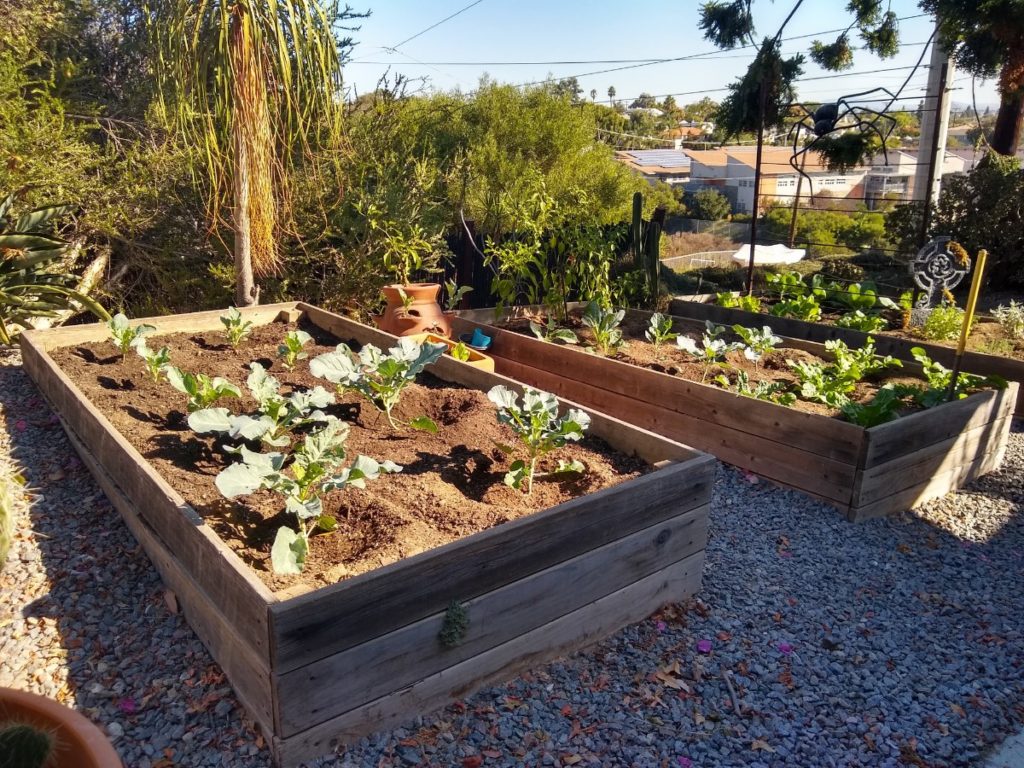
By the time we got back, his happy plants had turned wilty and uncomfortable in the conditions.
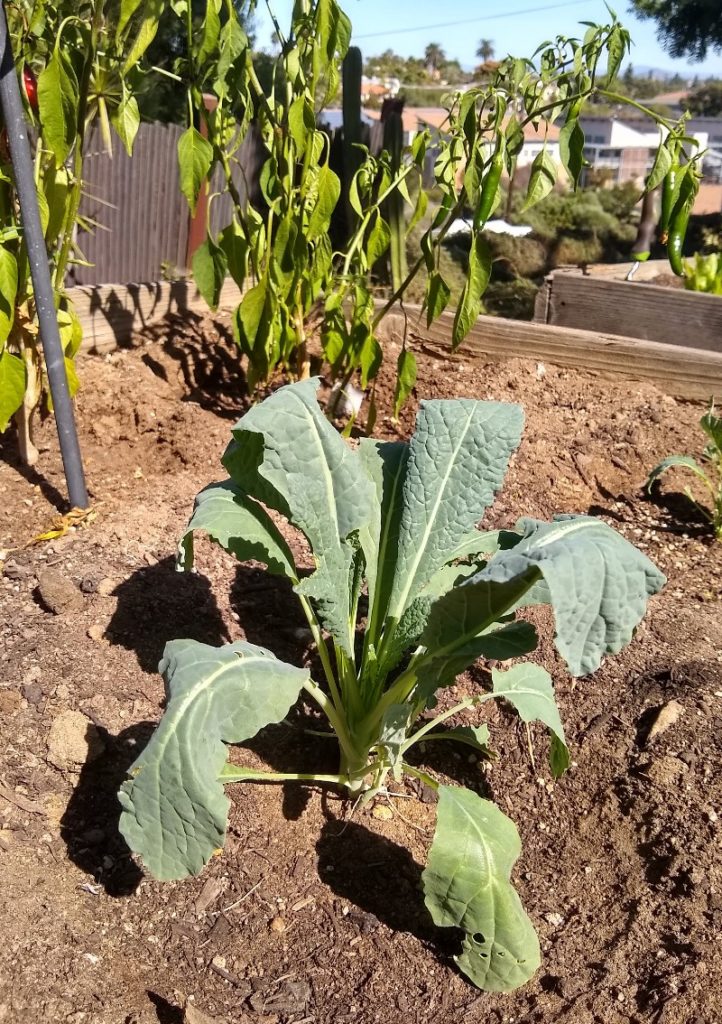
How are vegetables and fruit trees affected by Santa Anas, and how can we help them cope?
What are Santa Anas, exactly?
But first things first. What are Santa Anas, exactly? They are more than just winds, and it is every part of Santa Ana conditions that contributes to effects on your garden. If there is an official definition for Santa Anas, it might come from the National Oceanic and Atmospheric Administration, which says, “In southern California, a weather condition in which strong, hot, dust-bearing winds descend to the Pacific Coast around Los Angeles from inland desert regions.”
Normally, breezes in Southern California come from the ocean. They are west winds. And coming from the ocean, they are moist and cool.
During Santa Anas all is opposite. They are east winds, coming from the desert, so they are dry and warm.
Moreover, they are stronger than normal ocean breezes. Santa Anas hit the mountains that cradle the Southern California Bight, and they push over the mountains and through the passes with increased fury.
Often the winds lose velocity when they get close to the beach. This is especially true down south in San Diego County. (Where Erik and I surfed there was no wind, yet at my house twenty miles inland the wind was gusting around 30 miles per hour.)
Yet, even when the wind doesn’t make it to the beach, the warmth usually does. Santa Ana days near the beach can be dead calm and surprisingly warm, sometimes just as warm as the desert.
San Diego reached 91 degrees yesterday (October 24, 2019), and Santa Monica topped out at 92, while Palm Springs reached 93.
Desert to beach, the same temperatures. That’s not normal — except that it is, during Santa Anas.
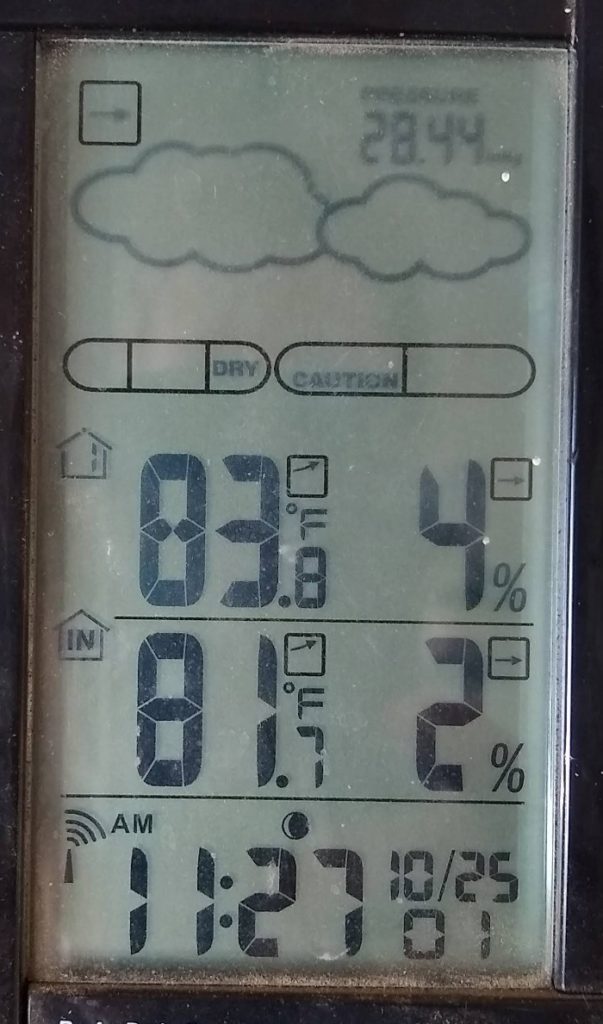
Water use of plants rises
Everything about Santa Ana conditions — wind, heat, low humidity — raises the amount of water that plants use. Santa Ana season is fall and winter, and despite days being shorter this time of year, the amount of water that a plant uses during Santa Anas can be similar to — or even exceed — summer.
For example, yesterday, October 24, the evapotranspiration rate measured at the CIMIS station in Escondido was 0.21 inches, which is about equal to the average for a summer day.
(What is the evapotranspiration rate?)
Watering during Santa Anas is often necessary, but watering just before the Santa Anas arrive is sometimes vital. Just as with a summer heat wave, you want your plants to enter stressful weather conditions fully hydrated. This allows them to cope with the wind, heat, and low humidity better; there’s no recovery necessary, just coping.
Also, these days the power utilities are more inclined to shut off electricity during Santa Anas, and your ability to irrigate might be dependent on that. If you’re on a well, then what can your generator and pump handle?
I’m not on a well, but my electricity was shut off during this Santa Ana event and that made one of my irrigation timers not work because the back-up battery had died without my knowledge. My fault. Glad I was around to turn on the valves by hand, but I’d watered things before the shutoff so they weren’t desperately thirsty anyway.
(How to know when strong Santa Anas are on their way? Occasionally, check the headlines at the National Weather Service: near Los Angeles, or near San Diego. The graphic at the top of this page comes from the forecast page of the National Weather Service, by the way.)
Trees topple or snap
Young trees with weak trunks must be staked well or they are vulnerable to being blown over, or even snapping in half, during Santa Anas. The same risk is there for trees that have imbalanced canopies.
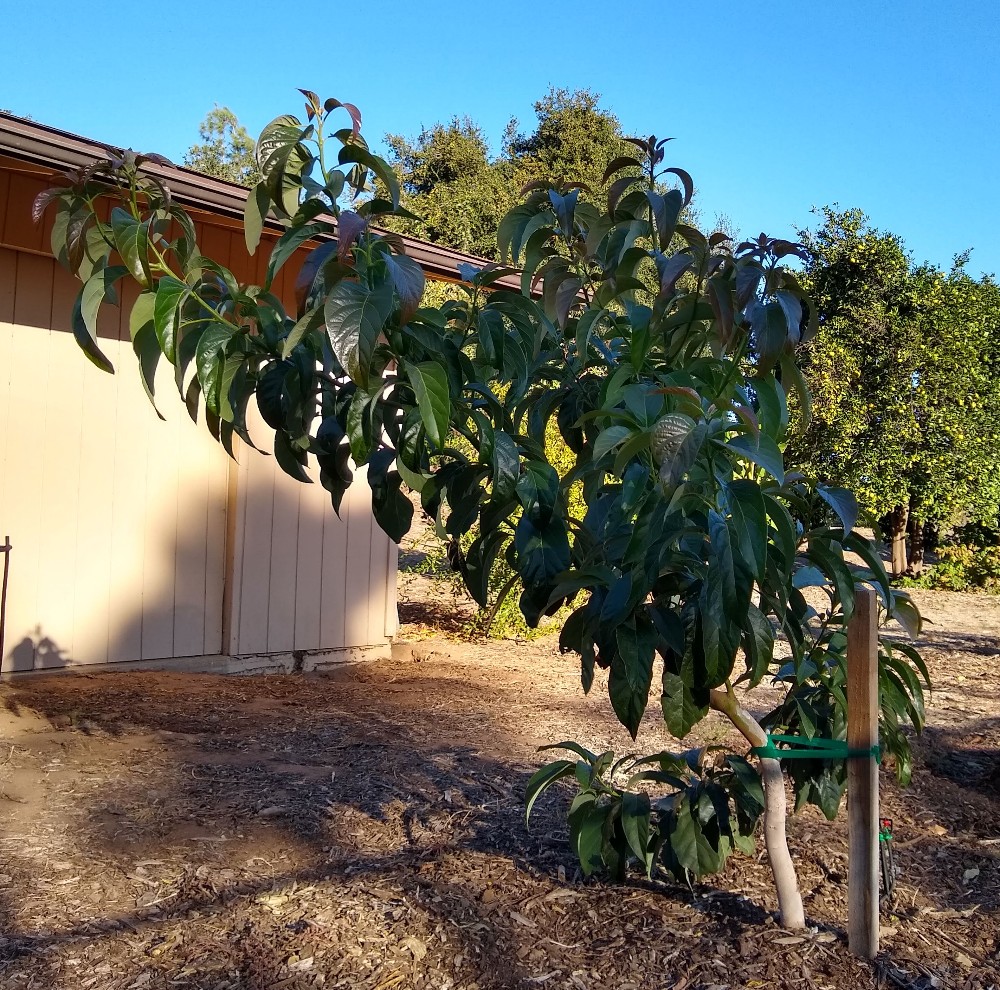
During one Santa Ana event, I had a Fuerte avocado tree blow over because the canopy was too heavy on one side.
Yesterday, I almost lost a branch that was carrying a heavy load of fruit on my Reed avocado tree. I had propped it up for support, but the winds still knocked over my support, again and again.
What to do? I sacrificed avocados and pruned back the limb. Rather that than lose the entire limb.
For young or imbalanced trees, prune and/or stake as necessary before the winds hit.
Fruit is knocked off
Since Santa Anas occur in the fall and winter, there are certain fruit trees that are vulnerable to having their fruit knocked off in the strong gusts. Avocados are definitely at risk, as are pomegranates and apples. My passion fruit vine has also dropped some fruit.
Unfortunately, there’s nothing much you can do to prevent this. You might harvest some of the apples that are on the exterior branches before the strong winds hit. Just pick the pomegranates up off the ground as they’re unlikely to be very damaged, unless critters get to them before you do.

As for avocados, if you live in a place that gets strong Santa Anas often, then you might consider growing certain varieties instead of others. Hass tends to drop fruit easily in Santa Ana winds. In contrast, Pinkerton and Lamb are two varieties that I’ve noticed hold onto their fruit with more tenacity.
This morning was windy and I was thinking about writing this post. Are my broccoli seedlings thirsty? Do any trees need staking assistance? Then smoke appeared over the hill to our east.
The Santa Anas were going to blow that fire straight into us. I started packing the car. Who cares about broccoli plants and avocado trees?
Gratefully, firefighters contained the burning hillside. And I could return to less serious garden thoughts.
You might also like to read my posts:
What to do in a Southern California garden in October
What to do in a Southern California garden in November
Fall/Autumn watering of fruit trees and vegetables
All of my Yard Posts are listed here.
These Yard Posts come to you without ads because of the support of lots of cool gardeners. Become one today!

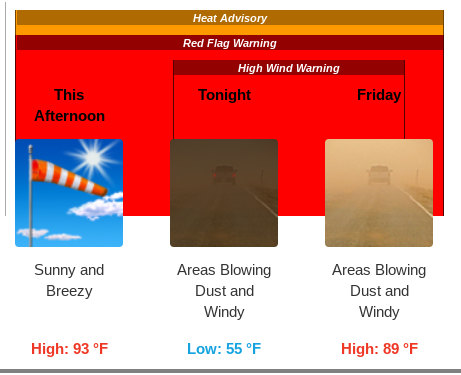


Thank you firefighters! Im sure some critters enjoyed the fallen fruit. But the real serious question is how was the surf?
Ha! Uncrowded, and that’s almost as appreciated as much as anything else these days!
I watered my avocados 2 days ago, right before the winds started. I’m glad I did!! I thought about you all day as I heard about the fire. Thank goodness for all the brave firefighters!!! And thanks for the reminder to water our thirsty plants!
Thank you for your especially relevant post! Very glad you are okay!
Do you know if smoke from nearby fires, firepits, and/or cigarettes affect our plant/tree friends?
Thank you.
Thank you, Linda. I do know that smoke affects plants, but how much smoke is necessary to affect plants significantly is something I’m unsure of.
I barbecue with wood fires near a Chinese pistache tree, and I notice toward the end of each year that the leaves that get brushed by the smoke always look stressed and drop first.
Decades ago when smog in the L.A. area was particularly bad, many avocado and citrus growers claimed to notice changes in harvest times and pest issues compared to before.
You can find articles online about past wildfires affecting everything from potatoes to wine grapes. If the smoke is thick, then the main thing it does is block sunlight, and plants can’t grow well without ample sunlight. Then there is the positive aspect of ash carrying plant nutrients so when that ash lands it is essentially fertilizer.
Very interesting! Thank you for your thoughtful reply. 🙂
Linda
Before reading this post today, I noticed my 1-year in the ground Carmen Hass tree suddenly leaning considerable. It grew from 3-feet when planted in September 2018 to 8-feet currently. When I went to it’s rescue, I immediately noticed my highest tree tape tied between two stakes had ripped, and the tree is clearly depending on it. I retied it and it seemed straight again. However, I stopped reading this post halfway through to go back out and add another (temporary) tie higher up secured it to a nearby fence, as the tree is 2-3 feet higher than my stakes. I would be really sad it if blew over or snapped off.
The young leaves of my cherimoya trees and Kona Sharwil avocado were burned crispy last week. I am 3 miles away from the ocean and it was HOT. My precious Sharwil was watered almost daily but not my cherimoyas because I did not anticipate that the leaves would burn. No damage on the Reed avocado. Thank you for your article. Will make a note for next year.
Hi!
I’m a new subscriber and my question is: When do I harvest my Lamb Hass? I live in the Central Valley(Visalia). I’ve got plenty of fruit on the tree now and it is almost the beginning of November. The temperature in the Central Valley varies. Right now it is about 66 degrees F. They’re all firm and there are some that are speckled with black dots. Any suggestions would be greatly appreciated. Thanks for your help
Hi,
See the harvest season section of my post, “The Lamb/Hass avocado tree: a profile.”
Two years ago, here in Lakeside, S.A. winds snapped my 3 year old beautiful Hass due to poor staking. So far this year we’ve avoided strong S.A. Went to Atkins on 10.17 looking for Gwen they were out of stock, so bought a #15 Reed and Pinkerton, so wonderful! 4 1/2′ for $65 each. On 10,27 from West Winds, ordered and three days later received a little Gwen, 2 1/2′ in a small sleeve, healthy looking little tree with 21 leaves. A few days later they posted “out of stock” for all their avos. Now have 9 varieties and 10 avos. Thanks for all the great info!
Hi Frank,
Glad you got your Gwen, and glad that Four Winds is now selling them (when in stock). Sounds like you’ve got an excellent array of varieties.
Was at a friend’s house yesterday who gets hit hard by Santa Anas and he had a couple mature trees nearly topple from last week. Hope this isn’t a bad year for those conditions.
Picked up a Fall 2019 copy of “From the GROVE” published by the California Avocado Industry.
On page 1 is an add from AgRx for Redox “diKaP” (0-31-50) which says “to support high fruit load and fight summer stress”. Most of my trees are young so I don’t have high fruit loads but I live inland from the coast, so I get Summer Stress. I thought I would try a bag or two. Went to the AgRx store in Fillmore and I forget whether it was 20 of 40 pounds but the cost was over $200 a bag. I didn’t choke but I did pass. I might think of coming back when my trees get more mature and have larger fruit loads
I was hoping to find some information about the winds causing the leaves (basically all leaves) to have blown off our guava, persimmons, avocado and pomegranate trees. These were planted in February of 2020, so they are very young. We were away labor day weekend and came home to an extremely burnt avocado… then shortly thereafter we had that wind storm that caused whatever leaves were left on the avocado, and then the other trees, to all blow off. Of course – it also blew the mulch all over the yard, etc… but my concern is the trees.
The burnt avocado seems to have a few lower branches doing well, not burnt, and one that seems to be the new leader. I have tied that to the stake and am interested to see how things progress.
But regarding the winds – is it okay that all leaves were blown off? I assume they will grow back and this is not a concern – but because these are so young I am somewhat nervous and figured I’d pose the question.
Thanks for any thoughts!
john
Hi John,
It’s not a good sign that so many leaves blew off your avocado. The persimmon and pomegranates naturally lose their leaves this time of year so that’s no big deal. The guava shouldn’t have lost so many leaves either, but most concerning is the avocado. It’s possible that the tree will grow many new leaves from down low starting later in the winter, but sometimes young avocado trees have a hard time recovering from extreme sunburn. Don’t be too disappointed or surprised if you end up needing to replace the tree.
Avocado trees are wimpy their first year or two. They’re unforgiving if you don’t give them enough water or protection from sun, heat, or cold. But after then they are much tougher.
Hi Greg, thanks for this site – it’s been so helpful. I have a question about avocado trees and wind. Everything I read says that avocado trees need “wind protection,” but how much wind is a problem if it’s not a hot wind? I don’t have Santa Ana winds; I’m in northern Monterey County about 8 miles from the coast, and most afternoons we get cool, moist winds from the ocean, usually about 15 mph and sometimes more. I planted a Fuerte this past winter, starting it with three stakes loosely tied, gradually weaned it off the stakes, and now it stands up straight without stakes when the air is still, but it bends somewhat when the afternoon wind is blowing. I want to plant a new Carmen Hass near it. What kinds of problems might a wind like mine cause? (My entire site gets this afternoon coastal wind, except an area behind that house that only gets a few hours of sun because it’s shaded by a tall grove of eucalyptus.)
Hi Tavy,
It sounds like you don’t have a wind problem. There are two common situations in California where winds are a problem.
One: Areas on the tops of hills or in canyons where Santa Anas are extra strong are a problem. What happens here is that the trees can’t hold much fruit to maturity because in most years there is a spell of strong winds that knock a bunch of fruit off the trees.
Two: Certain areas right next to the ocean that get a lot of cool, onshore wind. What happens here is that during the spring bloom the trees don’t set as much fruit as they would if they were in a warmer, calmer location.
But it doesn’t sound like you are in either of these situations.
It is January 22, 2022 at 4:23 a.m. in Altadena, California, and a very strong Santa Ana has been blowing since yesterday afternoon. When I got up to check on things, I could see city lights where they had been obscured by my giant white grapefruit tree. It was down. It has blown over twice before, and been uprighted and tied down. It is a beloved tree, constantly giving me more delicious grapefruit than I could ever eat. Is it worth trying again? I ask because it is over 50 years old. Should I just give up and plant a new one? If I do try to upright it, do you know who could do it?
A reminder: Don’t depend on the stake that came with your new avocado tree. My new Reed had its original 2″ X 2″ stake, and the trunk was a sturdy 1-3/8″ diameter. Both snapped off at ground level in a Santa Ana. The stake had rotted underground. I’m allowing the well established root system to grow so in time, I can add shoots from 1st, a Reed, plus other varieties.